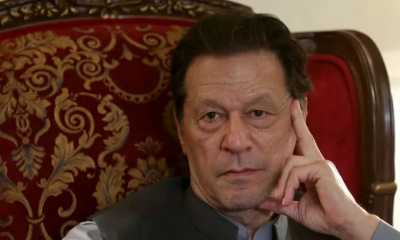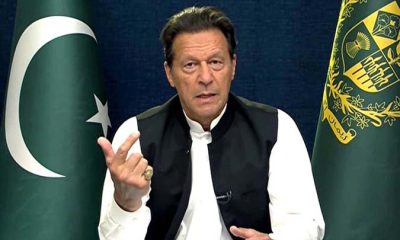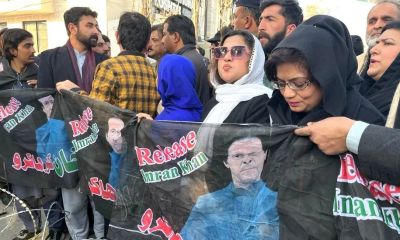Latest News
Pakistan election: PTI joins religious parties, PPP backs rival PMLN

Five days after Pakistan’s general election, two opposing parties, Pakistan Tehreek-e-Insaf (PTI) and Pakistan Peoples Party (PPP), have both announced plans to form a government – with the PTI allying with religious parties and the PPP forming a coalition with rival Pakistan Muslim League-Nawaz (PMLN).
The PTI leadership on Tuesday announced that its independent candidates would try to form a federal government and one in Punjab province by joining a coalition with the minority party Majlis-e-Wahdat-Muslimeen (MWM).
The party also said its candidates in Khyber Pakhtunkhwa province would ally with another religious party, Jamaat-e-Islami (JI), to form a government.
Thursday’s elections delivered a split mandate with no party securing a majority in the National Assembly. Independent candidates affiliated with jailed former Prime Minister Imran Khan’s PTI won the most seats. But to form a government, they still need to be part of a political party or a coalition.
In announcing the coalition plan on Tuesday, PTI spokesperson Raoof Hasan said he had been mandated by Khan to approach all political parties other than the “PPP, PMLN and MQM”, or Muttahida Qaumi Movement.
“Imran Khan has a clear message that formation of a government is the right of who had won the elections,” Hasan said at a press conference in Islamabad.
Former cricketer Khan was ousted from power in a parliamentary vote of no confidence in April 2022. The PTI was also forced to field its candidates as independents after its electoral symbol, a cricket bat, was stripped from it in January for violating election laws.
Khan has maintained he will not engage with three-time former Prime Minister Nawaz Sharif’s PMLN or former Foreign Minister Bilawal Bhutto-Zardari’s PPP, calling them “corrupt”.
In Thursday’s polls, PTI-backed candidates emerged on top with 93 seats in the National Assembly whereas the PMLN was the single biggest party with 75 seats. The PPP was the third highest with 54 seats. To form a government, a party or coalition needs a simple majority of 134 seats in the National Assembly out of the 266 that were voted on during the general election.
Besides the 266 directly elected seats, an additional 60 seats are reserved for women and 10 for minorities. Those seats are distributed among parties according to the ratio of seats they won, but independents will not receive these quota seats.
While two parties can form a coalition and still retain their individual identity and policies, independent candidates, once they join a party, must adhere to that party’s discipline and decisions.
The PTI has insisted that its singular majority was stolen in the election due to alleged tampering and vote manipulation. Barrister Gohar Ali Khan, the PTI’s interim party chief, said on Tuesday that the PTI believes it has won 180 seats, instead of 93. “We will share a white paper with all the details,” he added. Neither Hasan nor Gohar Ali Khan said who would be the party’s candidates for prime minister, speaker and deputy speaker in parliament.
Coalition between PPP and PMLN
Hours after the PTI’s announcement, the PPP and PMLN said at a press conference that they would form a new coalition and join with smaller parties to lead the country.
Although they did not specify who would lead the government, PMLN spokesperson Marriyum Aurangzeb said on the social media platform X that Nawaz Sharif had nominated his younger brother and Former Prime Minister Shehbaz Sharif for the post.
Earlier on Tuesday, Bhutto-Zardari, the PPP chairperson, said his party would endorse the PMLN’s candidate for the position of prime minister and would align with it.
He said the PPP decided against taking any role in the cabinet, and he would not be putting his name forward for the premiership, “We do not have the mandate to form a government in the federation, and therefore, I will not be putting myself forward for the candidacy of the prime minister,” he said during a press conference in Islamabad.
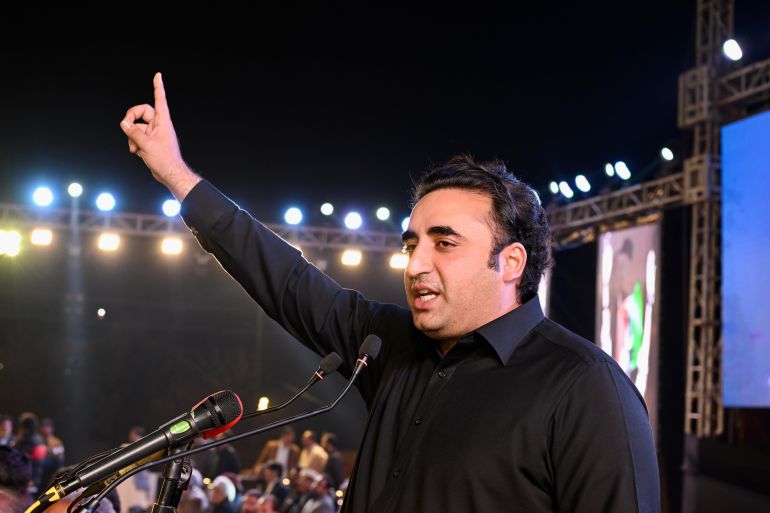
Bhutto-Zardari expressed his desire to see his father, former President Asif Ali Zardari, return to that position while also announcing the party would put candidates forward for Senate chairperson and speaker of the National Assembly.
“We ran this election on the manifesto based on public importance, and we want to restore political stability and want to end this environment of political toxicity,” the PPP chairperson said.
Political analyst Benazir Shah said the decision by the PPP seems to be a smart move. “The PPP has been trying to make inroads into Punjab, Pakistan’s most populous province, for the past few years. This is an opportunity for them to spend the next five years mobilising their party in the province, especially since these election results show weakening of PMLN’s vote bank,” she told Al Jazeera. “The PPP has its eyes set on 2029, not on 2024.”
Regarding the PTI, analyst Mehmal Sarfraz said it was incumbent on the party to ensure its winning candidates join the MWM so party discipline applies to them and they cannot jump ship.
However, she questioned Imran Khan, for refusing to engage with other political parties.
“This is not about any principle. This is about Khan’s narrative of hate against these parties and his divisive politics. It is unfortunate that PTI is not willing to talk to any other mainstream political party. Democracy is also about co-existence and tolerating other’s point of view, but PTI’s politics is essentially ‘either with us or against us’,” she told Al Jazeera.
Shah concurred, saying that while the election results show that Pakistani voters want to see the PTI in office, it appears Khan is still adamant on “politics of confrontation”.
“His refusal to sit with the PPP to form a government signals that Khan is still not ready to sit with political parties in the larger interest of democracy,” she added.
Sarfraz believes that, given the circumstances, the PPP made the right call by joining the PMLN alliance, adding that it is the PMLN that needs the PPP, not the other way around.
“No party has the numbers to form a government on its own. Ideally, the PPP would have wanted Bilawal Bhutto-Zardari to be the leader of the opposition. But options are limited, especially because of the PTI’s rigid stance. So this is effectively the only thing they could have done,” the Lahore-based analyst said.
(Aljazeera)
Latest News
Indian PM Modi arrives in Sri Lanka on a three day state visit

Prime Minister of India Narendra Modi arrived in the island a short while ago on a three-day state visit.
The Indian Prime Minister was received at the Katunayake International Airport by Sri Lanka’s Minister of Foreign Affairs Vijitha Herath.
PM Modi is accompanied by Minister of External Affairs S. Jaishankar, Indian National Security Advisor Ajit Doval, Indian Foreign Secretary and several senior officials of the Government of India.
Latest News
Special Train Services during Sinhala and Tamil New Year
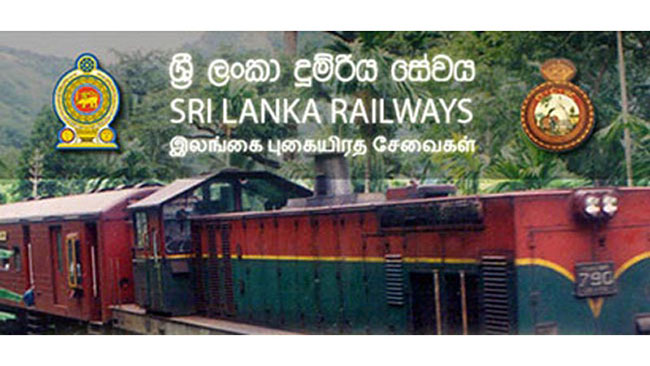
The General Manager of Railways has announced that the following special train services will operate during the Sinhala and Tamil New Year period.
1. From Colombo Fort to Badulla – departing Colombo Fort at 1930 hrs on 11th, 12th, 19th and 20th April
2. From Badulla to Colombo Fort – departing Badulla at 1750 hrs on 11th, 12th, 19th and 20th April
3. From Galle to Anuradhapura – departing Galle at 0400 hrs on 12th and 13th April
4. From Anuradhapura to Galle – departing Anuradhapura at 1500 hrs on 12th and 13th April
5. From Colombo Fort to Galle – departing Colombo Fort at 120 hrs on 10th, 11th, 15th and 20th April
6. From Galle to Colombo Fort – departing Galle at 0610 hrs on 11th, 12th, 16th and 21st April
7. From Colombo Fort to Galle – departing Colombo Fort at 1330 hrs on 12th and 13th April
8. From Colombo Fort to Kankasanthurai [Intercity Express] – departing Colombo Fort at 0530 hrs on 11th and 18th April
9. From Kankasanthurai to Colombo Fort [Intercity Express] – departing Kankasanthurai at 1350 hrs on 11th and 18th April
10. From Beliatta to Colombo Fort – departing Beliatta at 0825 hrs on 12th, 13th, 18th, 19th and 20th April
Business
Trump tariffs trigger steepest US stocks drop since 2020 as China, EU vow to hit back
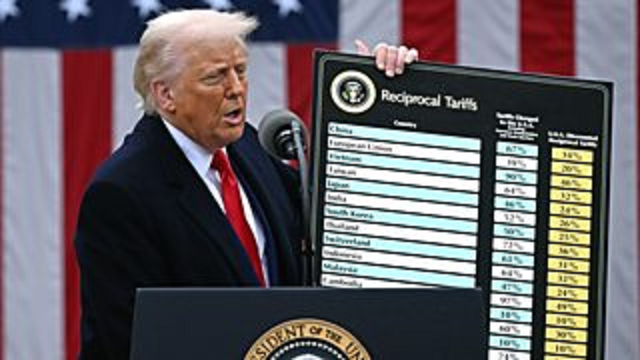
Global stocks have sunk, a day after President Donald Trump announced sweeping new tariffs that are forecast to raise prices and weigh on growth in the US and abroad.
Stock markets in the Asia-Pacific region fell for a second day, hot on the heels of the US S&P 500, which had its worst day since Covid crashed the economy in 2020.
Nike, Apple and Target were among big consumer names worst hit, all of them sinking by more than 9%.
At the White House, Trump told reporters the US economy would “boom” thanks to the minimum 10% tariff he plans to slap on imports in the hope of boosting federal revenues and bringing American manufacturing home.
The Republican president plans to hit products from dozens of other countries with far higher levies, including trade partners such as China and the European Union. China, which is facing an aggregate 54% tariff, and the EU, which faces duties of 20%, both vowed retaliation on Thursday.
Tariffs are taxes on goods imported from other countries, and Trump’s plan that he announced on Wednesday would hike such duties to some of the highest levels in more than 100 years.
The World Trade Organization said it was “deeply concerned”, estimating trade volumes could shrink as a result by 1% this year.
Traders expressed concern that the tariffs could stoke inflation and stall growth.
In early trading on Friday, Japan’s benchmark Nikkei 225 index fell by 1.8%, the Kospi in South Korea was around 1% lower and Australia’s ASX 200 dipped by 1.4%.
On Thursday, the S&P 500 – which tracks 500 of the biggest American firms – plunged 4.8%, shedding roughly $2tn in value.
The Dow Jones closed about 4% lower, while the Nasdaq tumbled roughly 6%. The US shares sell-off has been going on since mid-February amid trade war fears.
Earlier, the UK’s FTSE 100 share index dropped 1.5% and other European markets also fell, echoing declines from Japan to Hong Kong.
On Thursday at the White House, Trump doubled down on a high-stakes gambit aimed at reversing decades of US-led liberalisation that shaped the global trade order.
“I think it’s going very well,” he said. “It was an operation like when a patient gets operated on, and it’s a big thing. I said this would exactly be the way it is.”
He added: “The markets are going to boom. The stock is going to boom. The country is going to boom.”
Trump also said he was open to negotiating with trade partners on the tariffs “if somebody said we’re going to give you something that’s so phenomenal”.
On Thursday, Canada’s Prime Minister Mark Carney said that country would retaliate with a 25% levy on vehicles imported from the US.
Trump last month imposed tariffs of 25% on Canada and Mexico, though he did not announce any new duties on Wednesday against the North American trade partners.
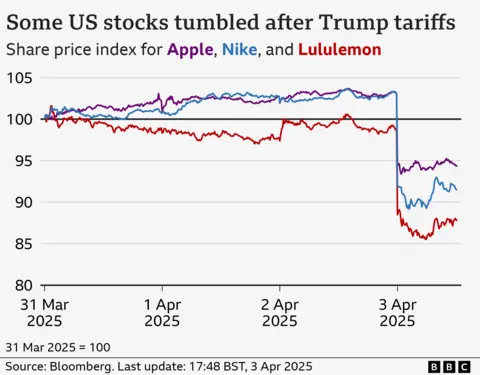
Firms now face a choice of swallowing the tariff cost, working with partners to share that burden, or passing it on to consumers – and risking a drop in sales.
That could have a major impact as US consumer spending amounts to about 10% – 15% of the world economy, according to some estimates.
While stocks fell on Thursday, the price of gold, which is seen as a safer asset in times of turbulence, touched a record high of $3,167.57 an ounce at one point on Thursday, before falling back.
The dollar also weakened against many other currencies.
In Europe, the tariffs could drag down growth by nearly a percentage point, with a further hit if the bloc retaliates, according to analysts at Principal Asset Management.
In the US, a recession is likely to materialise without other changes, such as big tax cuts, which Trump has also promised, warned Seema Shah, chief global strategist at the firm.
She said Trump’s goals of boosting manufacturing would be a years-long process “if it happens at all”.
“In the meantime, the steep tariffs on imports are likely to be an immediate drag on the economy, with limited short-term benefit,” she said.
On Thursday, Stellantis, which makes Jeep, Fiat and other brands, said it was temporarily halting production at a factory in Toluca, Mexico and Windsor, Canada.
It said the move, a response to Trump’s 25% tax on car imports, would also lead to temporary layoffs of 900 people at five plants in the US that supply those factories.
On the stock market, Nike, which makes much of its sportswear in Asia, was among the hardest hit on the S&P, with shares down 14%.
Shares in Apple, which relies heavily on China and Taiwan, tumbled 9%.
Other retailers also fell, with Target down roughly 10%.
Motorbike maker Harley-Davidson – which was subject of retaliatory tariffs by the EU during Trump’s first term as president – fell 10%.
In Europe, shares in sportswear firm Adidas fell more than 10%, while stocks in rival Puma tumbled more than 9%.
Among luxury goods firms, jewellery maker Pandora fell more than 10%, and LVMH (Louis Vuitton Moet Hennessy) dropped more than 3% after tariffs were imposed on the European Union and Switzerland.
“You’re seeing retailers get destroyed right now because tariffs extended to countries we did not expect,” said Jay Woods, chief global strategy at Freedom Capital Markets, adding that he expected more turbulence ahead.
[BBC]
-

 News5 days ago
News5 days agoBid to include genocide allegation against Sri Lanka in Canada’s school curriculum thwarted
-

 Sports6 days ago
Sports6 days agoSri Lanka’s eternal search for the elusive all-rounder
-

 News7 days ago
News7 days agoGnanasara Thera urged to reveal masterminds behind Easter Sunday terror attacks
-

 Sports2 days ago
Sports2 days agoTo play or not to play is Richmond’s decision
-

 News6 days ago
News6 days agoComBank crowned Global Finance Best SME Bank in Sri Lanka for 3rd successive year
-

 Features6 days ago
Features6 days agoSanctions by The Unpunished
-

 Features6 days ago
Features6 days agoMore parliamentary giants I was privileged to know
-

 Latest News4 days ago
Latest News4 days agoIPL 2025: Rookies Ashwani and Rickelton lead Mumbai Indians to first win


